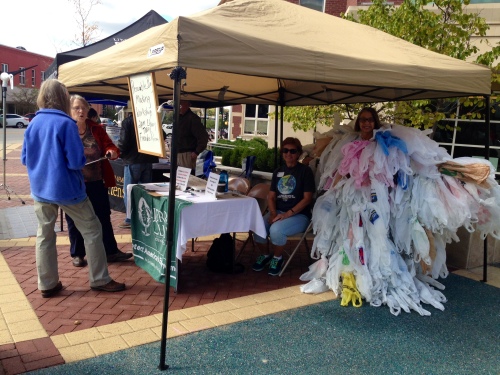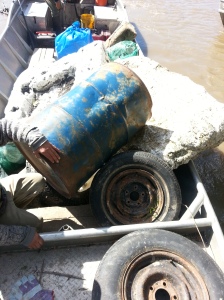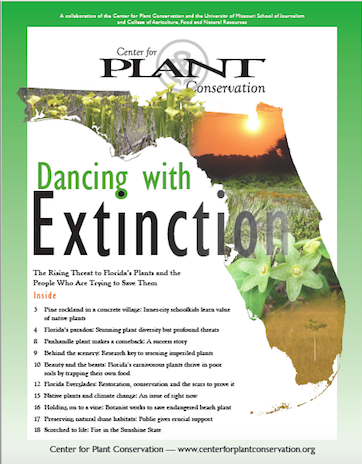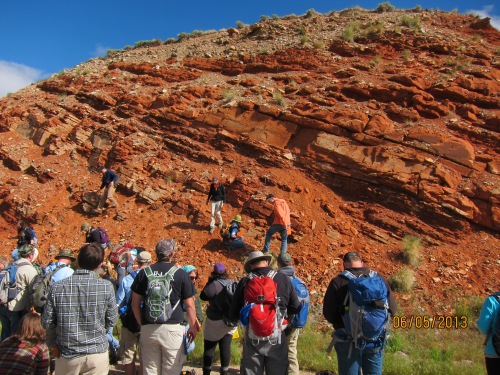-
Search It!
-
Recent Entries
- Dancing with Extinction: Florida Field Reporting, 2013
- Sustainable Living Fair attracts ‘green’ crowd
- Despite high water, group cleans Missouri River at Jefferson City
- Six Weeks in Sinks Canyon
- Field Reporting Institute Day 1 Reflection
- Sex on the river
- “Jack’s Fork River” More Like “Jack’s Cans River”
- Family Comes First at This Cattle Ranch
- Oh, What a Trip!
- Who’s to blame for water quality issues?
-
Links
Sustainable Living Fair attracts ‘green’ crowd

Sierra Club volunteers encourage passers-by to sign their petition of support for a single-use plastic bag ban in Columbia at the 2014 Sustainable Living Fair outside City Hall Saturday. (Photo by Jessica Stone)
By Jessica Stone
COLUMBIA — A plastic bag “monster” appeared outside of Columbia City Hall for the 2014 Sustainable Living Fair Saturday, but instead of terrorizing residents, the monster educated them about environmental waste.
“The average shopper uses 500 plastic bags per year,” said the monster, Osage Chapter Sierra Club volunteer Carolyn Amparan, with only her head and neckline visible in a bulky garb of 500 plastic bags.
Sierra Club volunteers took turns donning the plastic bag suit they call the “plastic bag monster” to attract passers-by to their booth to sign their petition of support for a single-use plastic bag ban in Columbia. The ordinance will be presented to the city council at Monday’s meeting.
Nancy Boon of Pierpont attended the fair to support building contractor Robyn Magner’s presentation on solar home design. Boon said Magner’s knowledge of passive solar and design principles, combined with her architectural plans, led to construction of Boon’s sustainable home in 1983. Boon said the reduction in her environmental impact has been worthwhile.
“There comes a time when doing it ideally is just not worth it, so you do the best you can,” Boon said, speaking up near the end of Magner’s lecture. “If you’re satisfied with keeping your environmental impact to a minimum, don’t fret for that last 10 percent, unless you’re real motivated to. But if you’re doing 80 percent efficiency on everything you’re doing in the house, you’re doing really well.”

More than a dozen educational booths on sustainable living were set up inside Columbia City Hall for the fair, which attracted environmental enthusiasts of all ages. (Photo by Jessica Stone.)
Stephanie Childress and her family traveled Jefferson City to see what the fair had to offer. She was most interested in learning more about rain barrels and listening to environmental speaker Christina Mattson’s presentation on ecologically friendly eating.
“The lady [Mattson] is vegan and I’m a vegetarian,” Childress said. “So I was interested in that, and she has children, too.”
Childress considers herself “eco-friendly.”
“I bring my own reusable bags to the grocery store, I compost, I save water,” she said. “I drive my family crazy.”
The fair attracted two Westminster College students who live in the EcoHouse. The house, built on campus, promotes eco-friendly living for students and the community.
“I really love getting to know more of what everyone else is doing trying to be more sustainable,” sophomore Olivia Andoe said. “At EcoHouse, we try to be more sustainable, so this seems like a perfect place to learn what other people are doing about that.”
The Sustainable Living Fair featured eight workshops on sustainable living philosophy, three off-site tours to solar buildings and more than a dozen educational booths promoting eco-friendly lifestyles.
Posted in Uncategorized
Tagged Osage Chapter Sierra Club, Sustainable Living Fair, Westminster College
Despite high water, group cleans Missouri River at Jefferson City
By Jessica Stone

A boatload of trash retrieved Saturday from the Missouri River near Jefferson City by volunteers from Missouri River Relief. (Photo by Jessica Stone)
JEFFERSON CITY — Strong winds and high waters couldn’t dampen the spirit of volunteers at the Missouri River Relief Big Muddy Clean-up in Jefferson City Saturday.
Volunteers checked in at Noren Access in Jefferson City, where River Relief staff assigned each group a cleanup location at nearby river accesses and public park areas. Volunteers picked up trash at 12 river and stream-side places in Jefferson City and Hartsburg. Designated cleanup sites included Turkey Creek, Ellis Porter Park and Wears Creek.
Missouri River Relief has participated in and hosted river cleanups since 2001, going as far as Nebraska over the course of a typical year. The group last cleaned the river at Jefferson City in 2011 because of high demand for cleanups in other communities, Missouri River Relief Director Jeff Barrow said.
This year’s cleanup here was different from other years because this week’s heavy rainfall made the river rise near flood stage, Barrow said. The cleanup was originally canceled for safety purposes, but the staff later decided conditions were acceptable and sent out two boats with more experienced volunteers to collect trash.
“Because of high river conditions, we’ve had to go to land-based cleanup,” Barrow said. “It just makes it a lot more complicated. People have to drive, convoy and get directions instead of just getting in the boat.”
Despite the complications, 80 volunteers, along with 20 River Relief crew members, picked up a considerable amount of trash, he said. In addition to the typical assortment of plastic and glass bottles, volunteers found an eclectic mix, including an old teddy bear, a compact car hood, a giant deflated inner tube, a grave marker and a huge piece of carpet.
Volunteer Jed Friedrichsen said he got involved with Missouri River Relief cleanups three years ago because he’s paddled in rivers for 50 years and has seen too much trash polluting the Missouri.
“It’s kind of sad to see the human footprint on things when there’s thousands of bottles of water and things like tires floating around,” Friedrichsen said.
When hundreds of volunteers show up at cleanups for a few hours, they make a significant difference in reducing that footprint, he said.
For Jen Davis, an internship with the group turned into a fun habit when she participated in her first river cleanup last spring and “immediately got addicted.” Davis said she has become “heavily involved” and helped coordinate the Boonville River Festival in September.
“I love it,” she said. “It’s a great thing to do. You get to meet all kinds of fun people, volunteer for the crew and camp out in places.”
The cleanup was one of many that were part of the group’s 2014 Big Muddy Clean Sweep, which will conclude on Oct. 18 in Herman.
Six Weeks in Sinks Canyon
Editor’s Note: In the summer of 2013, Teresa Avila spent six weeks as both a geology student and a science journalist at the University of Missouri’s Branson Field Laboratory, a geology field camp in Wyoming. Avila is pursuing a double major at MU — in Geology and in Science and Agricultural Journalism. She successfully completed the geology field class. She also reported and wrote the following piece of literary journalism as part of a journalism independent study class.
By Teresa Avila
A rusty red wall of rock sits at a tilted angle in central Wyoming. The highway next to it, U.S. 287, is a relatively quiet one. Especially so at 8:00 in the morning, when the wind rattling past green-silver sagebrush is still chilly enough for a jacket.
The low whooshing sound of an approaching vehicle echoes in the distance. Soon enough, a caravan of six white vans rushes into view. Leading the caravan is a navy blue truck, driven by a woman in her thirties with a tomboyish figure and a cloud of dark, curly hair above a tanned face. In the back of the truck, Miriam Barquero-Molina has a bicycle for when she makes her way back to the University of Missouri’s Branson Field Laboratory, about 22 miles and two hours away.
The truck and vans speed past the red rock, only to pull into a small gravel parking lot a few minutes later. From the vehicles clamber 43 undergraduate geology students, seven teaching assistants, one geology professor and one Australian shepherd/border collie mix.
The only thing in sight besides the fenced-in lot, the highway and a faded blue Porta Potty is a landscape of geology. Massive layers of rock rise up from the earth, their reds, pinks, oranges and tans dominating the landscape’s color palette far more than the ragged vegetation.
The students keep up a low chatter of conversation as they slather on sunscreen and adjust packs. Yesterday, the first official day of field camp, was all basic work done in the camp’s back yard. This will be the first real day in the field.
With a signal from Miriam, the crowd begins hiking toward the red tilted rock cut they passed earlier. Miriam’s dog — Kilah — prances through the students with her pink tongue hanging out at an angle.
They stop in front of the red rock and wait for the stragglers to catch up, observing the way the layers shoot upwards going from right to left.
Posted in Uncategorized
Field Reporting Institute Day 1 Reflection
The first day of the FRI has been overwhelming and completely awesome. I have already started a running list of story ideas to pursue in the future.
One of the biggest surprises for me is the openness of the traveling faculty. I’ve been able to sit next the most of them on the bus today, and have had some great conversations with them all.
One conversation that really sticks in my mind is my chat with Greg Laslo on our way from Peck Ranch to the restaurant. We talked about the possibility of writing news stories in more experimental forms. It really made me think about how we, as journalists, shouldn’t be afraid to break away from the way we learn to write in school. Maybe being a little creative will make our work more appealing to a wide audience.
And, I can’t wait for tomorrow’s adventures! But first, some sleep.
Posted in Uncategorized
Sex on the river
Zachary Matson
The Jack’s Fork River meanders slowly through a landscape of rolling Ozark Mountains — weathered to their core by hundreds of thousands of years of natural elements. Tall limestone bluffs, stained with dark lichens, tower over the river like the granite pillars of a national monument.
Narrow short-leaf pines and thick, sturdy oaks stand tall in thin soil and a rocky foundation. On the riverbanks, dull bushy sycamores envelope green willows, and a Small Copper butterfly’s orange wings shimmer in the midday sun as it flutters across the river, hunting for insects and mates.
Large schools of minnows gather around large, mossy rocks in the clear water while large trout circle like sharks.
King Fishers, swallows and a Green Heron beat their wings as they glide gracefully and methodically up and down the river corridor, inches above the slow moving current. Two or three Turkey Vultures dry their wide wings in a tall, dead tree, while another group picks at a carcass on the gravel bank below.
Water strider bugs hover over the water as swarms of mayflies celebrate their brief orgies in the great evolutionary struggle.
“These bugs are very happy today. It’s their one day when they can fly around and have sex,” said retired entomologist Dennis Kopp as he pointed to a swarm of mayflies, which hatch from their larval stages and breed for about 24 hours.
“It’s a sign of river health; it’s a sign of minimal river disturbance,” he said.
Posted in Uncategorized
“Jack’s Fork River” More Like “Jack’s Cans River”
By Annette Jenkins
Imagine floating down Jack’s Fork River. The cool water laps at your feet as you hang them out of your canoe, the warm sun overhead. Your cooler overflows with ice and cans of cold Mountain Dew. As you dig through the empty cans to find a full one, the breeze catches one and it’s tossed into the river, quickly filling with water and sinking. You can’t retrieve it. “It’s just one pop can.” But it can do more damage than you think.
Rebecca Landewe of The Nature Conservancy describes links between small things we don’t realize actually have a huge impact on the integrity and health of this river. Human litter and waste create bigger problems down the line than we can imagine.
More than one million visitors come to Jack’s Fork to float every summer. If one can is dropped for every five people, imagine the amount of trash swallowed-but not digested-by this pristine area.
Even something as small as using the woods as an outhouse during a long float trip can affect the health of the river, Landawe said. She described how human defecation adds nutrients to the water. “Algae feed on those nutrients, then suck oxygen out of the water. Other fish and wildlife need that oxygen,” Landawe said.
Landewe is working with the Department of Parks and Recreation to help educate the public on the treatment of the water in the popular floating season. She wishes people were more responsible when it came to keeping it a place everyone will want to visit, Landawe said.
Posted in Uncategorized
Family Comes First at This Cattle Ranch
By: Rachel Raines
The Barnitz family believes their cattle ranch isn’t just about the profit you get from beef.
Starting with only 12 acres in 1868, the Barnitz family has come a long way in building their family farm over the past decade. With over 1,000 head of cows, the Barnitz cattle ranch is one of the largest operations around.
Although the family takes on this large responsibility, they refuse to cut corners.
“We make extra steps to make sure we do everything we can for our live stalk,” Frank Barnitz, owner of the Barnitz family ranch, said.
While at the cattle ranch, we saw three baby calves that had been rejected by their mothers that the Barnitz family decided to take care of. The family will bottle feed these calves until they are able to live on their own.
The pride and love that the Barnitz family has for their cattle operation is contagious. In years to come, the family hopes more people will come visit their farm.
Posted in Uncategorized
Oh, What a Trip!
By: Rachel Raines
After more than 75 hours of field reporting, my brain is fried from an information overload. This weekend we traveled more than 500 miles across the state of Missouri, visiting sites and landmarks that I would have never thought to travel to, and meeting people from numerous different backgrounds. This trip was incredibly planned and easily one of the best learning experiences of my lifetime.
My main highlights on the trip were visiting Fort Leonard Wood, driving the elk tour, canoeing on jacks fork and visiting the cattle ranch. Each of these events were so interesting and places I could have spent endless amounts of time.
Today we visited the cattle ranch and jacks forks river. Both of these stops had so much heritage to learn from. I especially enjoyed riding down the river with JB Forbes and watching him take photos on the water. The colors of rocks, the dead trees and the numerous amounts of fish and minnows truly brought out a scenic story on the float trip. Visiting the cattle ranch was exciting as well. We witnessed the operations of a passed down family farm and heritage and passion behind their day to day operations. The family was extremely compassionate about their work with cattle and so proud to tour us thru their pastures and animals.
Now that the trip is over, I can not help but look back and appreciate everything we did. I feel so blessed to have met and worked alongside such great faculty and active members of the agriculture community. In the days to come I hope to take the facts I learned on this trip and apply them to my future work and life.
Posted in Uncategorized
Who’s to blame for water quality issues?
The Current River snakes it’s way through Missouri’s Ozark Mountains. Float down it and you’ll likely see turkey vultures riding thermals overhead. Cicadas on either side of the river chirp and oak trees sprout out of rock.
“It’s a trout fisherman’s paradise,” Dennis Kopp said.
Kopp, a retired entomologist professor at North Dakota State University, pointed out the mayflies, an indicator of high water quality, hovering above the river. There were too many to count.
The water looks the way Mother Nature intended. It appears clear enough to see the mossy rocks at the bottom. Trout swim underneath the canoe.
And there it is—someone’s Bud Light can; the sure sign of our collective impact on the environment.
The signs of our impact aren’t always as apparent as a beer can at the bottom of a river. Rebecca Landewe, Current River project manager said her team collects water quality samples as one way to gauge the quality of the water.
Human and horse excrement increase the level of bacteria in the water. In turn, more algae grows causing oxygen levels to decrease. This hurts the water quality for other wildlife who live in or otherwise depend on the river.
It’s a safe assumption on July 5th you won’t see as many mayflies.
Edited by Erin Schell
Posted in Uncategorized


